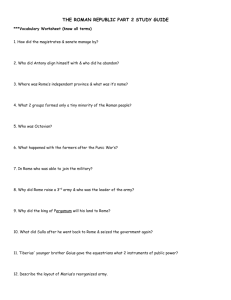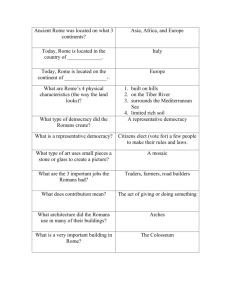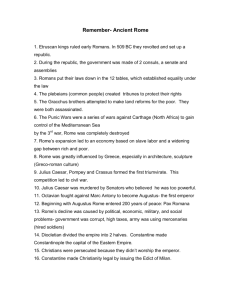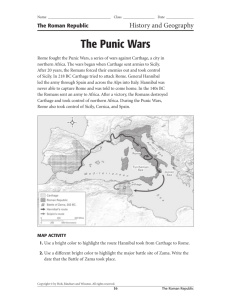Chapter 10, section 3 notes
advertisement
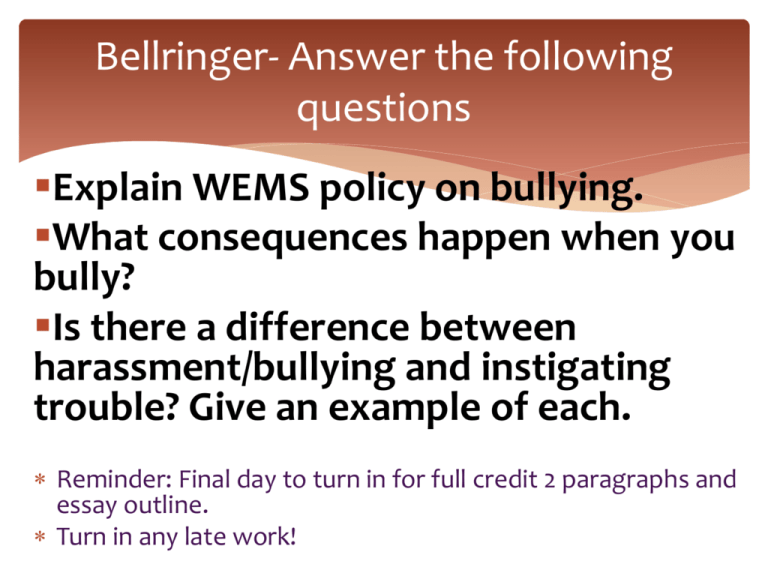
Bellringer- Answer the following questions Explain WEMS policy on bullying. What consequences happen when you bully? Is there a difference between harassment/bullying and instigating trouble? Give an example of each. Reminder: Final day to turn in for full credit 2 paragraphs and essay outline. Turn in any late work! Chapter 10, Section 3: The Late Republic I can explain how the later period of the Roman Republic was marked by wars of expansion and political crises. Vocabulary Section 3 Legions- A legion was a group of soldiers—as many as 6,000. Punic Wars- series of three wars found between Rome and Carthage, a city in northern Africa. Its significance showed the growing strength of Rome. End result of wars- Rome takes control of Northern Africa, Sicily, Corsica, and Spain- most of the Western Mediterranean region. See Notes Sections for Each Person Hannibal Gaius Marius Lucius Cornelius Sulla Spartacus Growth of Territory & Trade By about 400 BC, the Roman Empire was growing very quickly. Within 200 years, they had conquered all of Italy. Trade and shipping grew Rome’s wealth all over the Mediterranean Sea. Growth of Territory Territory mostly grew because of outside threats. The Romans paid people called the Gauls a lot of gold to leave Rome when they came to attack. Other groups wanted to get rich from the Romans, so they tried attacking Rome. The Romans defeated their attackers and took over their lands. Rome’s army was divided into legions. A legion was a group of soldiers—as many as 6,000. • The Roman army was very large, very strong, and very organized. • Legions of 6,000 soldiers were divided into groups called centuries, which had 100 soldiers. • This let the army adapt to their enemies. Farming and Trade Before Rome took over Italy, most Romans were farmers. Over time, more people headed for the city of Rome and very large farms grew along the countryside. Slaves worked on these farms. Sometimes the owners of the farm lived in Rome while others did the work! The large farms still couldn’t produce enough food for Rome’s growing population. Trade became very important to feed all of the people. Roman merchants would bring in food, metals, and slaves. In return, the Roman government created coins out of copper, silver, and other metals. Reading Check Identifying Cause and Effect Why did the Romans conquer their neighbors? The Punic Wars Over time, many groups wanted to fight Rome, but Rome continued to win. This allowed for Rome to expand all over the Mediterranean. The fiercest battles were the PUNIC WARS. The PUNIC WARS were against CARTHAGE, a city in Northern Africa. There were three wars within 120 years. The Three Wars 1. 264 BC – The first war lasted 20 years. Carthage attacked the island of Sicily. The Romans won and took over Sicily. 2. 218 BC – Carthage attacked the city of Rome. A great military leader named Hannibal tried to lead the Carthage army to take Rome, but was unsuccessful. The Romans launched a quick attack on Carthage. Hannibal was defeated at the city of Zama. Romans won again. The Three Wars Continued 3. 140 BC – The Romans were afraid Carthage was getting strong again, so the senators advised the consuls to go to war. Rome attacks Carthage. They win. They burn the city, kill most of its people, sell the rest into slavery and throw salt over where the city used to be so nothing would ever grow there again. Hannibal- Vocabulary Info. Hannibal considered to be one of the greatest military generals of the ancient world. He began the 2nd Punic War by attaching one of Rome’s allies in Spain. Later committed suicides to prevent himself from being captured by the Romans. Hannibal’s army included about 80 war elephants. These elephants made it over the Alps mountain range in their attack on Rome! Lived 247-183 BC was from Carthage, North Africa Later Expansion Rome gained control of much of the Western Mediterranean from the Punic Wars. When the Romans took over Greece, they accepted many Greek views on literature, art, philosophy, religion, and education. As the territory grew, rich Romans kept getting richer and poor Romans were getting poorer. Many feared that this would lead to violence. What can we infer from this map? Tiberius and Gaius Gracchus They were brothers that served as tribunes. Tiberius wanted to start farms for poor Romans to keep them happy. He wanted these farms on public land that wealthy Romans took illegally. The public liked the idea, but the rich people hated it. Riots broke out in the city and Tiberius was killed. Like his brother, Gaius Gracchus wanted to start farms. He sold food cheaply to poor people. His ideas angered many powerful Romans and he was killed just like his brother during a riot. Class Divisions Tiberius and Gaius Gracchus deaths showed that big disagreements between rich and poor existed in Rome near the end of the republic. Their violent deaths would change Roman politics to where Romans would see violence as a political weapon to be used against those with whom they disagreed. Gaius Marius In 107 BC, the army needed more troops very badly. Gaius Marius, a consul, encouraged poor people to join the army. Before this, only men who owned property could join. Many poor and unemployed men join the army. Marius was a great military leader. His soldiers were very loyal to him. The support of the soldiers gave Marius political power. Following his example, other leaders wanted to start armies to gain power. Lived 157-86 BC was from Rome Lucius Cornelius Sulla Lucius Cornelius Sulla became a consul in 88 BC and quickly became a rival of Gaius Marius. He created his own army, which led to a civil war in Rome. A civil war is when people from the same country are fighting. In the end, Sulla won. Sulla declared himself dictator and used his power to punish enemies Maintained many traditional ideas though such as the Senate and actually increased its power during his rule. Lived 138-77 BC was from Rome Spartacus Not long after Sulla died, Spartacus, a former gladiator, led thousands of slaves in a rebellion to demand freedom. Spartacus and his army defeated an army sent to stop them in southern Italy. Over time, though, Spartacus was killed in battle. Lived 109–71 BC was Thracian, area of Greece Setting an example The military leader during this rebellion, Marcus Crassus, crucified (tied up or nailed to a cross like Jesus) 6,000 of Spartacus's followers on the road between Rome and Capua to set an example. The rebellion was over, but the republic’s problems were not. Homework In this section you learned about many major figures in Roman history. Choose one of them and create a poster depicting them and their biographical information. You may draw or print off pictures from the internet. You must do this on your own. Your poster should be colorful and contain at minimum 5 facts about this figure. Due Thursday 4/10 Rubric 50 point daily grade 25- Facts are listed- contains correct information (5 points per fact) 10- Colored 15- Neatly drawn, hand writing is clear, no mistakes Other Reminders: Vocabulary Due Friday 4/11 Study Guide Review Due Thursday 4/10 (Will have all day Wednesday to work on it) Test Friday 4/11
